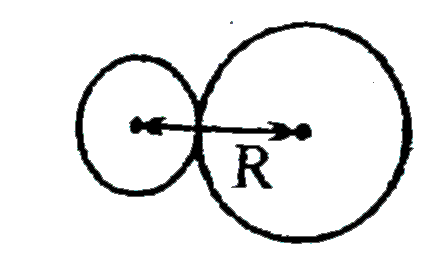The first nuclear reaction ever observed was by ernest Rutherford in 1919. It was triggered by alpha particles incident on an isotope of nitrogen .147 N. He observed a proton was emitted along with another element x. Let us assume that .147 N nucleus was initially stationary. For this reaction to occur, alpha-particle must touch the nitrogen nucleus. The distance between their centres at this moment is d. For this problem, we will neglect the effect of outer electrons in .147 N. Symbols have their usual meanings.
Value of d is
A
R0(21/3+71/3)
B
R0(22/3+72/3)
C
R0(22/3+142/3)
D
R0(22/3+141/3
Video Solution
Text Solution
The correct Answer is:D
d=RN+Rp
R=R0A1/3=R0141/3+R041/3

|
Updated on:21/07/2023
Related Playlists
- BOOK - BANSALCHAPTER - MASTER PRACTICE PROBLEMEXERCISE - Reasoning75videos
MASTER PRACTICE PROBLEM
- BOOK - BANSALCHAPTER - MASTER PRACTICE PROBLEMEXERCISE - Multiple objective131videos
MASTER PRACTICE PROBLEM
- BOOK - BANSALCHAPTER - MASTER PRACTICE PROBLEMEXERCISE - Additional topic70videos
MASTER PRACTICE PROBLEM
- BOOK - BANSALCHAPTER - FLUID MECHANICSEXERCISE - PYQS AIEEE10videos
FLUID MECHANICS
- BOOK - BANSALCHAPTER - SEMICONDUCTORSEXERCISE - CBSE Question32videos
SEMICONDUCTORS
Similar Practice Problems
- Question 1 - Select One
The first nuclear reaction ever observed was by ernest Rutherford in 1919. It was triggered by alpha particles incident on an isotope of nitrogen .147 N. He observed a proton was emitted along with another element x. Let us assume that .147 N nucleus was initially stationary. For this reaction to occur, alpha-particle must touch the nitrogen nucleus. The distance between their centres at this moment is d. For this problem, we will neglect the effect of outer electrons in .147 N. Symbols have their usual meanings.
X is an isotope ofANitrogenBOxygenCFluorineDCarbon - Question 1 - Select One
The first nuclear reaction ever observed was by ernest Rutherford in 1919. It was triggered by α-particles incident on an isotope of nitrogen .147N. He observed a proton was emitted along with another element x. Let us assume that .147N nucleus was initially stationary. For this reaction to occur, α-particle must touch the nitrogen nucleus. The distance between their centres at this moment is d. For this problem, we will neglect the effect of outer electrons in .147N. Symbols have their usual meanings.
X is an isotope ofANitrogenBOxygenCFluorineDCarbon - Question 1 - Select One
The first nuclear reaction ever observed was by ernest Rutherford in 1919. It was triggered by alpha particles incident on an isotope of nitrogen .147 N. He observed a proton was emitted along with another element x. Let us assume that .147 N nucleus was initially stationary. For this reaction to occur, alpha-particle must touch the nitrogen nucleus. The distance between their centres at this moment is d. For this problem, we will neglect the effect of outer electrons in .147 N. Symbols have their usual meanings.
The minimum initial kinetic energy of alpha-particle so that reaction can occur isA18ke2R0(22/3+142/3)B14ke2R0(22/3+141/3)C18ke2R0(22/3+141/3)D14ke2R0(22/3+72/3) - Question 1 - Select One
When an alpha particle emitted from an unstable nucleus, the mass number of the nucleus
Aincreases by 2Bincreases by 4Cdecreases by 4Ddecreases by 2 - Question 1 - Select One or More
In an endoergic nuclear reaction an incoming particle collides with stationary nucleus
Akinetic energy of incoming particle is greater than Q-value of reaction in ground frameBkinetic energy of incoming particle is equal to the Q-value of reaction in center of mass frameClinear momentum of particle-nucleus system is conservedDenergy is released in the process - Question 1 - Select One
An artifical radioactive isotope gave 147N after two successive β-particle emissions. The number of neutrons in the parent nucleus must be
A9B14C5D7 - Question 1 - Select One
If an α-particle is incident directly towards a nucleus then it will stop when the distance between them is the distance of closest approach. Which of these is correct?
AIts kinetic energy is converted into released radiationBWhen its kinetic energy becomes zero then it converts into electrostatic potential energyCAt distance of closest approach the potential energy of the α-particle becomes zeroDA β-particle will show the same behaviour as an α-particle
Similar Questions
Write a balanced equation for the reaction of N14 with α− particles.
View Solution" The perpendicular distance of the initial velocity vector of the "alpha" - particle form the centre of nucleus is called "
View SolutionA nucleus with mass number 184 initially at rest emits an α particle. If the Q value of the reaction is 5.5 MeV, calculate the kinetic energy of the energy of the α particle
View Solution

